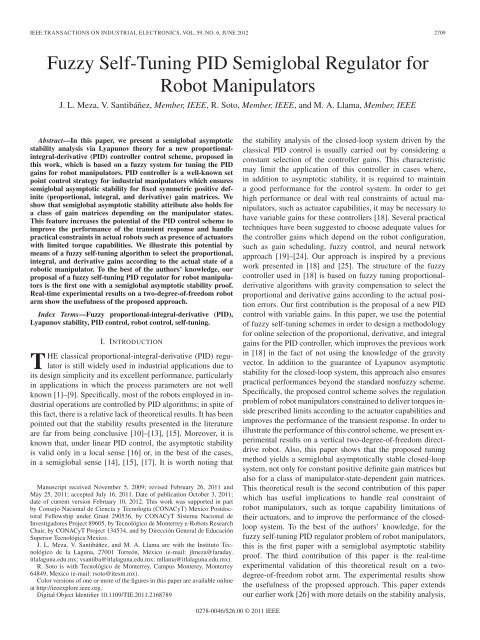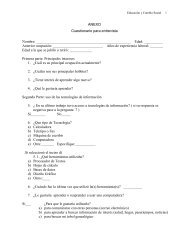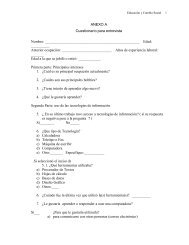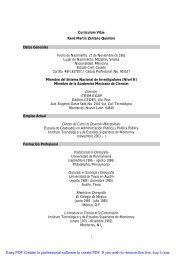Fuzzy Self-Tuning PID Semiglobal Regulator for ... - Homepages
Fuzzy Self-Tuning PID Semiglobal Regulator for ... - Homepages
Fuzzy Self-Tuning PID Semiglobal Regulator for ... - Homepages
You also want an ePaper? Increase the reach of your titles
YUMPU automatically turns print PDFs into web optimized ePapers that Google loves.
IEEE TRANSACTIONS ON INDUSTRIAL ELECTRONICS, VOL. 59, NO. 6, JUNE 2012 2709<strong>Fuzzy</strong> <strong>Self</strong>-<strong>Tuning</strong> <strong>PID</strong> <strong>Semiglobal</strong> <strong>Regulator</strong> <strong>for</strong>Robot ManipulatorsJ. L. Meza, V. Santibáñez, Member, IEEE, R.Soto,Member, IEEE, and M. A. Llama, Member, IEEEAbstract—In this paper, we present a semiglobal asymptoticstability analysis via Lyapunov theory <strong>for</strong> a new proportionalintegral-derivative(<strong>PID</strong>) controller control scheme, proposed inthis work, which is based on a fuzzy system <strong>for</strong> tuning the <strong>PID</strong>gains <strong>for</strong> robot manipulators. <strong>PID</strong> controller is a well-known setpoint control strategy <strong>for</strong> industrial manipulators which ensuressemiglobal asymptotic stability <strong>for</strong> fixed symmetric positive definite(proportional, integral, and derivative) gain matrices. Weshow that semiglobal asymptotic stability attribute also holds <strong>for</strong>a class of gain matrices depending on the manipulator states.This feature increases the potential of the <strong>PID</strong> control scheme toimprove the per<strong>for</strong>mance of the transient response and handlepractical constraints in actual robots such as presence of actuatorswith limited torque capabilities. We illustrate this potential bymeans of a fuzzy self-tuning algorithm to select the proportional,integral, and derivative gains according to the actual state of arobotic manipulator. To the best of the authors’ knowledge, ourproposal of a fuzzy self-tuning <strong>PID</strong> regulator <strong>for</strong> robot manipulatorsis the first one with a semiglobal asymptotic stability proof.Real-time experimental results on a two-degree-of-freedom robotarm show the usefulness of the proposed approach.Index Terms—<strong>Fuzzy</strong> proportional-integral-derivative (<strong>PID</strong>),Lyapunov stability, <strong>PID</strong> control, robot control, self-tuning.I. INTRODUCTIONTHE classical proportional-integral-derivative (<strong>PID</strong>) regulatoris still widely used in industrial applications due toits design simplicity and its excellent per<strong>for</strong>mance, particularlyin applications in which the process parameters are not wellknown [1]–[9]. Specifically, most of the robots employed in industrialoperations are controlled by <strong>PID</strong> algorithms; in spite ofthis fact, there is a relative lack of theoretical results. It has beenpointed out that the stability results presented in the literatureare far from being conclusive [10]–[13], [15]. Moreover, it isknown that, under linear <strong>PID</strong> control, the asymptotic stabilityis valid only in a local sense [16] or, in the best of the cases,in a semiglobal sense [14], [15], [17]. It is worth noting thatManuscript received November 5, 2009; revised February 26, 2011 andMay 25, 2011; accepted July 16, 2011. Date of publication October 3, 2011;date of current version February 10, 2012. This work was supported in partby Consejo Nacional de Ciencia y Tecnología (CONACyT) Mexico PostdoctoralFellowship under Grant 290536, by CONACyT Sistema Nacional deInvestigadores Project 89605, by Tecnológico de Monterrey e-Robots ResearchChair, by CONACyT Project 134534, and by Dirección General de EducaciónSuperior Tecnológica Mexico.J. L. Meza, V. Santibáñez, and M. A. Llama are with the Instituto Tecnológicode la Laguna, 27001 Torreón, Mexico (e-mail: jlmeza@faraday.itlalaguna.edu.mx; vsantiba@itlalaguna.edu.mx; mllama@itlalaguna.edu.mx).R. Soto is with Tecnológico de Monterrey, Campus Monterey, Monterrey64849, Mexico (e-mail: rsoto@itesm.mx).Color versions of one or more of the figures in this paper are available onlineat http://ieeexplore.ieee.org.Digital Object Identifier 10.1109/TIE.2011.2168789the stability analysis of the closed-loop system driven by theclassical <strong>PID</strong> control is usually carried out by considering aconstant selection of the controller gains. This characteristicmay limit the application of this controller in cases where,in addition to asymptotic stability, it is required to maintaina good per<strong>for</strong>mance <strong>for</strong> the control system. In order to gethigh per<strong>for</strong>mance or deal with real constraints of actual manipulators,such as actuator capabilities, it may be necessary tohave variable gains <strong>for</strong> these controllers [18]. Several practicaltechniques have been suggested to choose adequate values <strong>for</strong>the controller gains which depend on the robot configuration,such as gain scheduling, fuzzy control, and neural networkapproach [19]–[24]. Our approach is inspired by a previouswork presented in [18] and [25]. The structure of the fuzzycontroller used in [18] is based on fuzzy tuning proportionalderivativealgorithms with gravity compensation to select theproportional and derivative gains according to the actual positionerrors. Our first contribution is the proposal of a new <strong>PID</strong>control with variable gains. In this paper, we use the potentialof fuzzy self-tuning schemes in order to design a methodology<strong>for</strong> online selection of the proportional, derivative, and integralgains <strong>for</strong> the <strong>PID</strong> controller, which improves the previous workin [18] in the fact of not using the knowledge of the gravityvector. In addition to the guarantee of Lyapunov asymptoticstability <strong>for</strong> the closed-loop system, this approach also ensurespractical per<strong>for</strong>mances beyond the standard nonfuzzy scheme.Specifically, the proposed control scheme solves the regulationproblem of robot manipulators constrained to deliver torques insideprescribed limits according to the actuator capabilities andimproves the per<strong>for</strong>mance of the transient response. In order toillustrate the per<strong>for</strong>mance of this control scheme, we present experimentalresults on a vertical two-degree-of-freedom directdriverobot. Also, this paper shows that the proposed tuningmethod yields a semiglobal asymptotically stable closed-loopsystem, not only <strong>for</strong> constant positive definite gain matrices butalso <strong>for</strong> a class of manipulator-state-dependent gain matrices.This theoretical result is the second contribution of this paperwhich has useful implications to handle real constraint ofrobot manipulators, such as torque capability limitations oftheir actuators, and to improve the per<strong>for</strong>mance of the closedloopsystem. To the best of the authors’ knowledge, <strong>for</strong> thefuzzy self-tuning <strong>PID</strong> regulator problem of robot manipulators,this is the first paper with a semiglobal asymptotic stabilityproof. The third contribution of this paper is the real-timeexperimental validation of this theoretical result on a twodegree-of-freedomrobot arm. The experimental results showthe usefulness of the proposed approach. This paper extendsour earlier work [26] with more details on the stability analysis,0278-0046/$26.00 © 2011 IEEE
MEZA et al.: FUZZY SELF-TUNING <strong>PID</strong> SEMIGLOBAL REGULATOR FOR ROBOT MANIPULATORS 2711matrices as functions of the robot configuration. This leads tothe following proposed control law:∫ tτ = K p (˜q)˜q − K v (˜q) ˙q + K i (ω) ˜q(σ)dσ (8)where K p (˜q),K v (˜q), and K i (ω) are positive definite diagonaln × n matrices, whose entries are denoted by k pi (˜q i ), k vi (˜q i ),and k ii (ω i ), respectively, ˜q = q d − q denotes the position errorvector, and ˙ω = α˜q − ˙q, with α>0.For stability analysis purposes, the control law (8) can berewritten as [31], [33]τ =K ′ p(˜q)˜q−K v (˜q) ˙q+K ′ i(ω)∫ t00(α˜q(σ)+ ˙˜q(σ))dσ (9)where K ′ p(˜q) =K p (˜q) − (K i (ω)/α) and K ′ i (ω) =(K i (ω)/α), with α>(λ M {K i }/λ m {K p }).This latter condition ensures that K ′ p(˜q) > 0.Theα constantis introduced in order to make easier the stability analysis, andthis will be used as a parameter of the Lyapunov function.Assumption 1: There exist positive constants k pli , k pui , k vli ,k vui , k ili , and k iui such that Lemma 1 can be applied. That is∫˜q12 ˜qT K pu˜q ′ ≥0∫˜q12 ˜qT K vu˜q ≥12 ωT K ′ iuω ≥0∫ ω0ξK p(ξ)dξ ′ ≥ 1 2 ˜qT ′K pl˜q (10)ξK v (ξ)dξ ≥ 1 2 ˜qT K vl˜q (11)ξK ′ i(ξ)dξ ≥ 1 2 ωT K ′ ilω (12)where K pu, ′ Kpl ′ , K vu, K vl , K iu ′ , and K′ ilare n × n constantpositive definite diagonal matrices whose entries arek pu ′ i,kpl ′ i,k vui ,k vli ,k iu ′ i, and kil ′ i, respectively, with i =1, 2,...,n.Assumption 2: In an ɛ-neighborhood N(ω,ɛ)={ω ∈ IR n :‖ω‖ n∑j=1and α is chosen in such a way that it satisfiesk vli∑ nj=1 max q |M ij (q)| >α>max q∣ ∣∣∣ ∂g i (q)∂q j∣ ∣∣∣(16)k ilik pli − ∑ nj=1 max q |∂g i (q)/∂q j | .(17)B. Time Derivative of the Lyapunov Function CandidateThe time derivative of the Lyapunov function candidate (15)along the trajectories of the closed-loop equation (13) is˙V (˜q, ˙q, ω) =− ˙q T [K v (˜q) − αM(q)] ˙q − α˜q T C(q, ˙q) T ˙q−α˜q T [K p (˜q) − K i (ω)/α] ˜q − α˜q T [g(q d ) − g(q)]where we have used the Leibnitz’ rule <strong>for</strong> differentiation ofintegrals and Property 1. Again, following similar steps given
© 2005 IEEE. Personal use of this material is permitted. Permission from IEEE must beobtained <strong>for</strong> all other uses, in any current or future media, including reprinting/republishingthis material <strong>for</strong> advertising or promotional purposes, creating new collective works, <strong>for</strong> resaleor redistribution to servers or lists, or reuse of any copyrighted component of this work in other works.http://dx.doi.org/10.1109/SAHCN.2005.1557082APT-nQhS(x 0 ,y 0 ) tRb(x,y)wT (x 0 ,y 0 )Fig. 3. A rectangle PQRS of infinitesimal size placed inside A, and adjacentto its boundary around point (x 0 , y 0 ).line. Conservation of data requires that:∫ RS∫ρ b (s) ds +−∫ PSPQRS[T · ˆt] ds −ρ(x, y) dA =∫ QP[T · ˆn] ds +∫ RQ[T · ˆt] ds.As the rectangle is very small, this equation can be approximatedby:wρ b (x 0 , y 0 ) + whρ(x 0 , y 0 ) ≃− h[T(x 0 , y 0 ) · ˆt] − w[T(x 0 , y 0 ) · ˆn] + h[T(x 0 , y 0 ) · ˆt].By dividing by w, and then taking h → 0, we arrive at thecondition:ρ b = −[T · ˆn], (5)which must hold at any point C(s) along C.III. PHYSICAL LAYER MODELSIn order to calculate the minimum number of wireless nodesneeded to carry the traffic from the sources to the sinks, weneed to specify the capabilities of the nodes. As our relevantprimitive quantities are the functions T(x, y) and d(x, y), weneed to specify which values <strong>for</strong> T(x, y) are acceptable at apoint (x, y), given that we have a density of nodes d(x, y)at that point. Clearly, if d(x, y) = 0, then we must have thatT(x, y) = 0; furthermore, the larger d(x, y) is, the larger thesize of T(x, y) can be. But the precise relation between thetwo quantities will depend on the physical layer used.A. Bandwidth Limited Physical LayersLet the wireless nodes be communicating over a commonwireless channel of some finite bandwidth. Nodes can eithertransmit or receive at the same time. When receiving, a nodeis susceptible to thermal noise of power N, same <strong>for</strong> all nodes.When transmitting, a node X uses a power level P , same <strong>for</strong>all nodes, and a node Y at a distance |X − Y | will receive thesignal with power KP |X − Y | −α , where K is a normalizingconstant and α > 2. Let {X k ; k ∈ T } be the set of transmittingFig. 4. A square of side ɛ, centered at the point (x 0 , y 0 ). If the node densityat that point is d(x 0 , y 0 ), then there are ɛ 2 d(x 0 , y 0 ) nodes in the square and,with high probability, a ‘highway system’ can be constructed that consists ofΘ(ɛ √ d(x 0 , y 0 )) highways, each relaying c 1 W bps from the left side to theright side.nodes at a given time instant. The transmission from node X ito node X j is received successfully iffP K|X i − X j | −αN + ∑ k∈T ,k≠i P K|X > β.k − X j |−αThis means that a reception is successful iff the Signal toInterference and Noise Ratio (SINR) is above a given thresholdβ. All successful transmissions happen with rate W bps,which we implicitly take to be a function of β and theavailable bandwidth. This physical layer model is criticallycharacterized by the fact that bandwidth is limited. Indeed, ifthere was infinite bandwidth, each transmission could occupya frequency band by itself, and communication would only behampered by the presence of the thermal noise, and not by theinterference from competing transmissions.Consider a location (x 0 , y 0 ) of the network. We would liketo determine how much traffic can pass through that location,given that the node density there is d(x 0 , y 0 ). For this, let usconstruct a small square of side ɛ, centered at (x 0 , y 0 ), andoriented so that the traffic flow function T(x 0 , y 0 ) is verticalto one of its sides, as shown in Fig. 4. The precise numberand placement of nodes in the square will depend on howthe network is constructed, but a reasonable assumption isto assume that the nodes are thrown randomly in the square,according to a spatial Poisson process of intensity d(x 0 , y 0 ).There<strong>for</strong>e, the expected number of nodes in the square will ben = ɛ 2 d(x 0 , y 0 ).Technically, we would like to establish the maximum value<strong>for</strong> the norm |T(x 0 , y 0 )| of the traffic flow function T(x 0 , y 0 ).For this, we need to calculate the maximum volume of trafficthat can be carried into the left edge and out of the rightedge of the square. Fortunately <strong>for</strong> us, we do not need to doany real work, as this problem was recently solved in [12].There, it was shown (as a side result) that the maximumpossible traffic that can be carried from the left side to
MEZA et al.: FUZZY SELF-TUNING <strong>PID</strong> SEMIGLOBAL REGULATOR FOR ROBOT MANIPULATORS 2713TABLE ILOOKUP TABLE FOR THE FUZZY RULE BASE i =1,...,nFig. 1.Input membership functions.Fig. 2.Output membership functions.where, in our case, the input x will be the state |˜q i | or |ω i | andthe output y will be the gain k pi ,ork vi ,ork ii .B. Rule Base and Inference EngineA fuzzy rule base <strong>for</strong> the case of each 3n Mamdani-typeelementary FLT with one input x and one output y is given bythe general canonical IF-THEN rule <strong>for</strong>m [35]IF xisA l THEN yisB l (23)where A l and B l are fuzzy sets and l =1,...,mis the numberof rules. We define three positive trapezoidal fuzzy sets, namely,big (B), medium (M), and small (S), to cover the input variable,whose membership functions are shown in Fig. 1, and threepositive singleton fuzzy sets, namely, big (B), medium (M),and small (S) to cover the output variable, whose membershipfunctions are shown in Fig. 2; hence, the number of rules m isthree.The designed fuzzy rule base is given as follows:IF x is S THEN y is BIF x is M THEN y is MIF x is B THEN y is Swhere x is either |˜q i | or |ω i | and y is either k pi or k vi or k ii ,i =1,...,n.The first rule specifies that, <strong>for</strong> a small position error, weshould apply a big k p in order to reduce still more this error.The second one specifies that, <strong>for</strong> a medium position error, wemust apply a medium k p , and the last rule specifies that, <strong>for</strong> abig position error, we need to apply a small k p in order to avoidtorque saturation. With regard to derivative gain k v , a similarcriterion is used taking into account that, <strong>for</strong> big position errors,it is suitable to have small damping, to avoid an oscillatoryresponse. For the case of integral gains, a similar criterion isFig. 3.Block diagram fuzzy self-tuning <strong>PID</strong> control.used taking into account that, <strong>for</strong> big |ω i |, it is suitable to havesmall k i to avoid undesirable oscillations. Table I summarizesthe fuzzy rules applied to each proportional, derivative, andintegral tuner.Evaluation of the rules is realized by using Mamdani’sproduct inference engine [35].C. Defuzzification MethodThe defuzzification strategy chosen in this paper is thecenter average method [35]. There<strong>for</strong>e, the output y can becomputed asy =∑ ml=1 ȳl µ A l(x)∑ ml=1 µ A l(x) (24)where ȳ = {k 1 ,k 2 ,k 3 } denotes the centers of the output membershipfunctions B l .There<strong>for</strong>e, <strong>for</strong> a given input x, the output y can be computedstraight<strong>for</strong>ward from (24) as it was pointed out in [25]. ThisFLT has the feature that, under simple conditions, its output yis upper and lower bounded by strictly positive constants. Thisfeature allows to fulfill completely Assumptions 1 and 2. Ablock diagram of the self-tuning <strong>PID</strong> control scheme is shownin Fig. 3.D. <strong>Tuning</strong> of the GainsAs previously described, the basic FLT is invoked to determinethe proportional, integral, and derivative gains. Thus, a set
2714 IEEE TRANSACTIONS ON INDUSTRIAL ELECTRONICS, VOL. 59, NO. 6, JUNE 2012bounds:|τ 1 |≤200 [N · m] and |τ 2 |≤15 [N · m]. With the endof supporting the effectiveness of the proposed controller, wehave used a squared signal whose amplitude is increased ordecreased in magnitude every 2 s. More specifically, the robottask is coded in the following desired joint positions:q d1 (t) =q d2 (t) ={ 45◦if 0 ≤ t
MEZA et al.: FUZZY SELF-TUNING <strong>PID</strong> SEMIGLOBAL REGULATOR FOR ROBOT MANIPULATORS 2715Fig. 5. Desired and actual positions 1 <strong>for</strong> the fuzzy self-tuning <strong>PID</strong> controland classical <strong>PID</strong>.Fig. 7. Applied torque to the joint 1 <strong>for</strong> the fuzzy self-tuning <strong>PID</strong> control andclassical <strong>PID</strong>.Fig. 6. Desired and actual positions 2 <strong>for</strong> the fuzzy self-tuning <strong>PID</strong> controland classical <strong>PID</strong>.origin of the state space of the closed-loop system is semiglobalasymptotically stable.With the end of getting a fair comparison, we have tuned thefixed gains of the classical <strong>PID</strong> controller in accordance withthe conditions given in Proposition 1, and we have chosen thosegains that yield the best per<strong>for</strong>mance in the sense of minimumrise time, without overshoot, and avoiding the possibility tosaturate the actuators. The best tuning <strong>for</strong> the fixed <strong>PID</strong> gains isobtained with= {3.5} [Nm/deg]= {0.16} [Nm/deg]= {0.96} [Nm sec/deg]= {0.35} [Nm sec/deg]= {2.09} [Nm/(deg sec)]k i2 = {0.105} [Nm/(deg sec)] .k p1k p2k v1k v2k i1Even so, we have permitted the fixed gains of the <strong>PID</strong> schemeto have an initial peak in the torque command of the elbowactuator slightly above of the torque limits during 2.5 · 10 −3s. Indeed, the control equipment is protected by software inorder to not demand, in the practice control, actions abovethe actuator torque constraints, which means that, in fact, wehave permitted that the torque 2 is saturated initially during twosample times.The experimental results are shown in Figs. 5–8. They showthe desired and actual joint positions and the applied torques <strong>for</strong>the fuzzy self-tuning <strong>PID</strong> control and the classical <strong>PID</strong> control.From Figs. 5 and 6, one can observe that the transient responsesof the links <strong>for</strong> the classical <strong>PID</strong> control are acceptable <strong>for</strong> thefirst step, but <strong>for</strong> the following changes of the step magnitude,Fig. 8. Applied torque to the joint 2 <strong>for</strong> the fuzzy self-tuning <strong>PID</strong> control andclassical <strong>PID</strong>.Fig. 9. Proportional gain k p1 .transient responses are not really good and the accuracy ofpositioning is not satisfactory. This is due to the fact thatthe control gains are constant, and they cannot be changed inaccordance with the values of the states.The proposed fuzzy self-tuning <strong>PID</strong> controller was testedunder the same desired task. The transient responses q 1 andq 2 are shown in Figs. 5 and 6; by comparing these positionerrors with those obtained <strong>for</strong> the case of fixed gains, we see thatthe accuracy and the transient are improved by using the fuzzyself-tuning algorithm. Applied torques τ 1 and τ 2 are shown inFigs. 7 and 8; these figures show the evolution of the appliedtorques; both remain within the torque actuator limits. Theapplied torque τ 2 presents high-frequency fluctuations of smallmagnitude which are imperceptible <strong>for</strong> the mechanical system;this can be seen in the position response in Fig. 6.The improvement in the per<strong>for</strong>mance of the fuzzy self-tuningresponses is mainly due to the variable nature of the gainmatrices, whose evolution during the experiment can be seenin Figs. 9–14.
2716 IEEE TRANSACTIONS ON INDUSTRIAL ELECTRONICS, VOL. 59, NO. 6, JUNE 2012VII. CONCLUSIONFig. 10. Proportional gain k p2 .Fig. 11. Integral gain k i1 .In this paper, we have proposed a fuzzy adaptation scheme<strong>for</strong> tuning the proportional, integral, and derivative statedependentgains of a <strong>PID</strong> controller <strong>for</strong> robot manipulators.Moreover, a semiglobal asymptotic stability proof <strong>for</strong> the proposedfuzzy self-tuning <strong>PID</strong> controller <strong>for</strong> robot manipulators ispresented. The proposed approach allows to consider importantpractical features in real robots, such as achievement of desiredaccuracy and avoidance of working of the actuators’ torques beyondtheir capabilities. The per<strong>for</strong>mance of the proposed fuzzyscheme has been verified by means of real-time experimentaltests on a two-degree-of-freedom direct-drive robot arm.In summary, we have extended the stability analysis presentedin [34] from <strong>PID</strong> controllers with fixed gains to <strong>PID</strong>controllers with variable gains <strong>for</strong> robot manipulators. Furthermore,we have applied such an analysis in order to self-tune,via fuzzy logic, the proportional, derivative, and integral gainmatrices. The new resulting control scheme is superior to thatshown in [34] due to the use of variable gain matrices and isalso superior to control schemes introduced in [18] and [25],because the new proposed controller does not employ explicitlythe knowledge of the robot dynamics model. Our result is asynergy of [34] and [25].Fig. 12. Integral gain k i2 .Fig. 13. Derivative gain k v1 .Fig. 14. Derivative gain k v2 .REFERENCES[1] V. Mummadi, “Design of robust digital <strong>PID</strong> controller <strong>for</strong> H-bridge softswitchingboost converter,” IEEE Trans. Ind. Electron., vol. 58, no. 7,pp. 2883–2897, Jul. 2011.[2] R. J. Wai, J. D. Lee, and K. L. Chuang, “Real-time <strong>PID</strong> controlstrategy <strong>for</strong> maglev transportation system via particle swarm optimization,”IEEE Trans. Ind. Electron., vol. 58, no. 2, pp. 629–646,Feb. 2011.[3] K. Kim, P. Rao, and J. A. Burnworth, “<strong>Self</strong>-tuning of <strong>PID</strong> controller <strong>for</strong> adigital excitation control system,” IEEE Trans. Ind. Appl., vol. 46, no. 4,pp. 1518–1524, Jul./Aug. 2010.[4] R. Muszynski and J. Deskur, “Damping of torsional vibrations in highdynamicindustrial drives,” IEEE Trans. Ind. Electron., vol. 57, no. 2,pp. 544–552, Feb. 2010.[5] M. A. S. K. Khan and M. A. Rahman, “Implementation of a waveletbasedMR<strong>PID</strong> controller <strong>for</strong> benchmark thermal system,” IEEE Trans.Ind. Electron., vol. 57, no. 12, pp. 4160–4169, Dec. 2010.[6] R. E. Brown, G. N. Maliotis, and J. A. Gibby, “<strong>PID</strong> self-tuning controller<strong>for</strong> aluminum rolling mill,” IEEE Trans. Ind. Electron., vol. 29, no. 3,pp. 578–583, May/Jun. 1993.[7] S. Skoczowski, S. Domek, K. Pietrusewicz, and B. Broel-Plater, “Amethod <strong>for</strong> improving the robustness of <strong>PID</strong> control,” IEEE Trans. Ind.Electron., vol. 52, no. 6, pp. 1669–1676, Dec. 2005.[8] L. Guo, J. Y. Hung, and R. M. Nelms, “Evaluation of DSP-based <strong>PID</strong>and fuzzy controllers <strong>for</strong> DC–DC converters,” IEEE Trans. Ind. Electron.,vol. 56, no. 6, pp. 2237–2248, Jun. 2009.[9] J. Moreno-Valenzuela and R. Campa, “Two classes of velocity regulators<strong>for</strong> input—Saturated motor drives,” IEEE Trans. Ind. Electron., vol. 56,no. 6, pp. 2190–2202, Jun. 2009.[10] S. Arimoto and F. Miyazaki, “Stability and robustness of <strong>PID</strong> feedbackcontrol <strong>for</strong> robot manipulators of sensory capability,” in Robotics. ResearchFirst Int. Symp., M. Brady and R. P. Paul, Eds. Cambridge, MA:MIT Press, 1984, pp. 228–235.[11] CIRSSE Document 54 J. T. Wen and S. Murphy, <strong>PID</strong> Control <strong>for</strong> RobotManipulators1990.[12] P. Roco, “Stability of <strong>PID</strong> control <strong>for</strong> industrial robot arms,” IEEE Trans.Robot. Automation, vol. 12, no. 4, pp. 606–614, Aug. 1996.[13] Z. Qu and J. Dorsey, “Robust <strong>PID</strong> control robots,” Int. J. Robot. Autom.,vol. 6, pp. 228–235, 1991.[14] R. Ortega, A. Loria, and R. Kelly, “A semiglobally stable output feedbackPI 2 D regulator <strong>for</strong> robot manipulators,” IEEE Trans. Autom. Control,vol. 40, no. 8, pp. 1432–1436, Aug. 1995.
MEZA et al.: FUZZY SELF-TUNING <strong>PID</strong> SEMIGLOBAL REGULATOR FOR ROBOT MANIPULATORS 2717[15] J. Alvarez, I. Cervantes, and R. Kelly, “<strong>PID</strong> regulation of robot manipulators:Stability and per<strong>for</strong>mance,” Syst. Control Lett., vol. 41, no. 2,pp. 73–83, Oct. 2000.[16] S. Arimoto, Control Theory of Non-Linear Mechanical Systems: APassivity-Based and Circuit-Theoretic Approach. London, U.K.: Ox<strong>for</strong>dUniv. Press, 1996.[17] J. L. Meza, V. Santibañez, and R. Campa, “An estimate of the domain ofattraction <strong>for</strong> the <strong>PID</strong> regulator of manipulators,” Int. J. Robot. Autom.,vol. 22, no. 3, pp. 187–195, Jun. 2007.[18] R. Kelly, R. Haber, R. E. Haber, and F. Reyes, “Lyapunov stable controlof robot manipulators: A fuzzy self-tuning procedure,” Intell. Autom. SoftComput., vol. 5, no. 4, pp. 313–326, 1999.[19] S. Cong and Y. Liang, “<strong>PID</strong>-like neural network nonlinear adaptive control<strong>for</strong> uncertain multivariable motion control systems,” IEEE Trans. Ind.Electron., vol. 56, no. 10, pp. 3872–3879, Oct. 2009.[20] L. Mostefai, M. Denai, O. Sehoon, and Y. Hori, “Optimal control design<strong>for</strong> robust fuzzy friction compensation in a robot joint,” IEEE Trans. Ind.Electron., vol. 56, no. 10, pp. 3832–3839, Oct. 2009.[21] F.-J. Lin and P.-H. Chou, “Adaptive control of two-axis motion controlsystem using interval type-2 fuzzy neural network,” IEEE Trans. Ind.Electron., vol. 56, no. 1, pp. 178–193, Jan. 2009.[22] J. C. Shen, “<strong>Fuzzy</strong> neural networks <strong>for</strong> tuning <strong>PID</strong> controller <strong>for</strong> plantswith underdamped responses,” IEEE Trans. <strong>Fuzzy</strong> Syst., vol. 9, no. 2,pp. 333–342, Apr. 2001.[23] C. H. Tsai, C. H. Wang, and W. S. Lin, “Robust fuzzy model-followingcontrol of robot manipulators,” IEEE Trans. <strong>Fuzzy</strong> Syst., vol. 8, no. 4,pp. 462–469, Aug. 2000.[24] H. B. Kazemian, “The SOF-<strong>PID</strong> controller <strong>for</strong> the control of a MIMOrobot arm,” IEEE Trans. <strong>Fuzzy</strong> Syst., vol. 10, no. 4, pp. 523–532,Aug. 2002.[25] M. A. Llama, R. Kelly, and V. Santibañez, “A stable motion control system<strong>for</strong> manipulators via fuzzy self-tuning,” <strong>Fuzzy</strong> Sets Syst., vol. 124, no. 2,pp. 133–154, 2001.[26] J. L. Meza, V. Santibáñez, R. Soto, and M. A. Llama, “Stable fuzzy selftuning<strong>PID</strong> control of robot manipulators,” in Proc. IEEE Int. Conf. Syst.Man Cybern., San Antonio, TX, Oct. 2009, pp. 2698–2703.[27] M. Spong, S. Hutchinson, and M. Vidyasagar, Robot Modeling andControl. Hoboken, NJ: Wiley, 2006.[28] D. Koditschek, “Natural motion <strong>for</strong> robot arms,” in Proc. IEEE Conf.Decision Control, Las Vegas, NV, 1984, pp. 733–735.[29] P. Tomei, “Adaptive PD controller <strong>for</strong> robot manipulators,” IEEE Trans.Robot. Autom., vol. 7, no. 4, pp. 565–570, Aug. 1991.[30] R. Kelly and R. Carelli, “A class of nonlinear PD-type controllers <strong>for</strong>robot manipulators,” J. Robot. Syst., vol. 13, no. 12, pp. 793–802,Dec. 1996.[31] R. Kelly, V. Santibañez, and A. Loria, Control of Robot Manipulators inJoint Space. New York: Springer-Verlag, 2005.[32] H. K. Khalil, Nonlinear Systems, 3rd ed. Englewood Cliffs, NJ: Prentice-Hall, 2002.[33] R. Ortega, A. Loría, P. Nicklasson, and H. Sira-Ramirez, Passivity-BasedControl of Euler–Lagrange Systems. New York: Springer-Verlag, 1998.[34] V. M. Hernandez-Guzman, V. Santibañez, and R. Silva-Ortigoza, “A newtuning procedure <strong>for</strong> <strong>PID</strong> control of rigid robots,” Adv. Robot., vol. 22,no. 9, pp. 1007–1023, 2008.[35] L.-X. Wang, A Course in <strong>Fuzzy</strong> Systems and Control. Englewood Cliffs,NJ: Prentice-Hall, 1997.[36] F. Reyes and R. Kelly, “Experimental evaluation of model-basedcontrollers on a direct-drive robot arm,” Mechatronics, vol. 11, no. 3,pp. 267–282, Apr. 2001.J. L. Meza was born in Torreon, Coahuila, Mexico.He received the M.S. and Ph.D. degrees in electricalengineering from Instituto Tecnológico de la Laguna,Torreon, Mexico, in 1985 and 2006, respectively.He is currently a Research Professor with theDivision de Estudios de Posgrado e Investigacion,Instituto Tecnológico de la Laguna. His researchinterests are in the areas of robot control, nonlinearcontrol <strong>for</strong> applications in mechatronics, andpassivity-based control.V. Santibáñez (M’96) received the B.S. and M.Sc.degrees in electronics engineering from InstitutoTecnológico de la Laguna, Torreon, Mexico, in 1977and 1984, respectively, and the Ph.D. degree fromCentro de Investigación Científica y de EducaciónSuperior de Ensenada Research Center, Ensenada,Mexico, in 1997.From 1977 to 1981, he was with the respective IndustrialElectronics Departments of the iron and steelindustry at Altos Hornos de Mexico and MetalurgicaMexicana Peñoles. From 1989 to 1990, he was withthe Instituto de Automatica Industrial, Consejo Superior de InvestigacionesCientíficas, Madrid, Spain. He is currently a Professor with the InstitutoTecnológico de la Laguna. His research interests are robot control, nonlinearsystems control, and fuzzy control.R. Soto (M’86) received the Ph.D. degree in electricalengineering from the University of Texas,Arlington, in 1990.He is currently an Associate Director <strong>for</strong> Researchwith Tecnológico de Monterrey, Monterrey, Mexico,where he is also a Professor with the Department ofMechatronics, School of Engineering, and a Codirectorof the Research Chair in Robotics. His researchinterests are in the areas of robotics, nonlinear andneuro-fuzzy control, and fuzzy systems <strong>for</strong> engineering.He has published in journals and conferencescited in Institute <strong>for</strong> Scientific In<strong>for</strong>mation Web and Scopus in the area ofcontrol systems.Dr. Soto has been a member of the National System of Researchers (SNI) inMexico since 1993.and automation.M. A. Llama (M’99) was born in San Pedro,Coahuila, Mexico. He received the B.S. degree inelectronics and communications engineering fromInstituto Tecnológico y de Estudios Superiores deMonterrey, Monterrey, Mexico, in 1977, the M.Sc.degree in electrical engineering from The Universityof Texas, Austin, in 1981, and the Ph.D. degree inelectrical engineering from Instituto Tecnológico dela Laguna (ITL), Torreon, Mexico, in 2001.He has been with ITL since 1982. His currentresearch interest is in fuzzy logic applied to robotics






